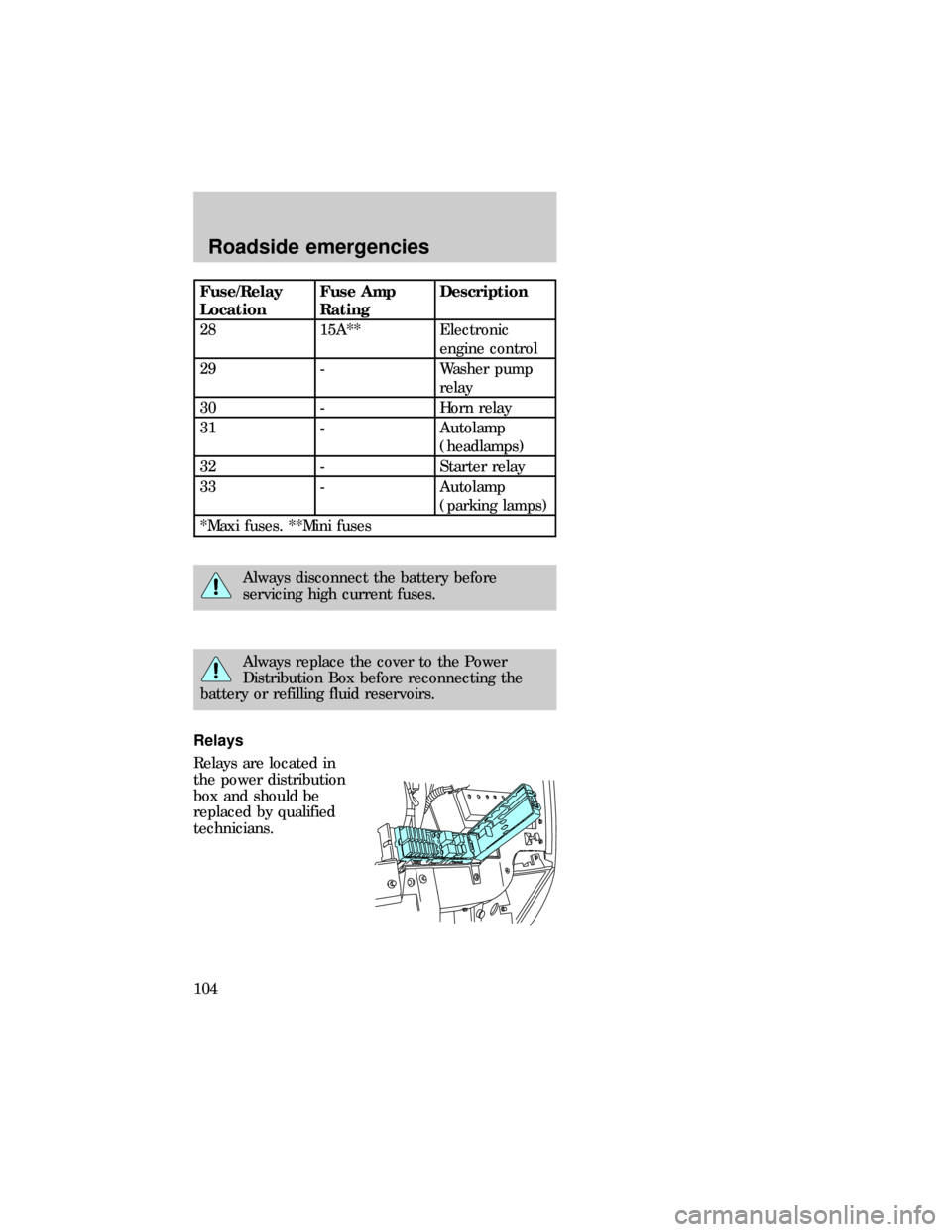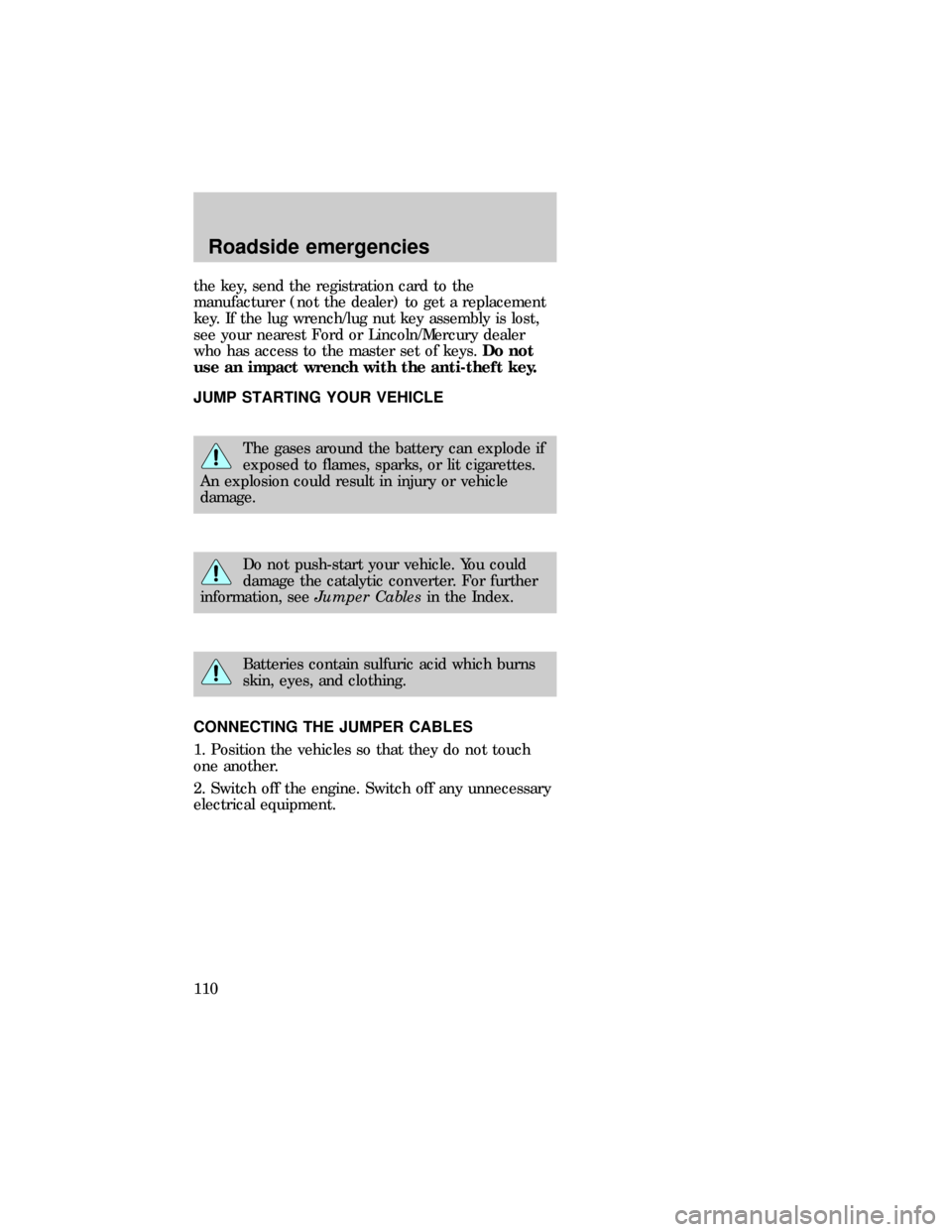Mercury Sable 1997 Owner's Manuals
Sable 1997
Mercury
Mercury
https://www.carmanualsonline.info/img/33/11165/w960_11165-0.png
Mercury Sable 1997 Owner's Manuals
Trending: lights, cooling, oil type, coolant temperature, air condition, interior lights, fuel fill door release
Page 101 of 167
Fuse/Relay
LocationFuse Amp
RatingDescription
23 5A GEM remote
entry, anti-theft
24 5A Integrated
control panel,
RCC,
speedometer
25 10A OBD II
26 15A Decklid release
27 10A Battery saver
28 15A Brake lamps,
speed control
29 15A Hazard flashers,
multi-function
switch
30 15A High beams,
daytime
running lamps,
instrument
cluster
31 5A Tail lamps
32 10A Integrated
control panel,
climate
controls, heated
mirrors
33 5A Power windows,
lock
illumination
34 - Battery saver
relay
35 - Driver door
unlock relay
Roadside emergencies
101
Page 102 of 167
Fuse/Relay
LocationFuse Amp
RatingDescription
36 - Rear defroster
relay
37 - Interior lamps
relay
38 - One touch
window down
relay
39 - Accessory delay
relay
Power distribution box
The power distribution
box is located in the
engine compartment
near the battery. The
power distribution box
contains high-current
fuses that protect your
vehicle's main electrical
systems from
overloads.
The high-current fuses are coded as follows:
Fuse/Relay
LocationFuse Amp
RatingDescription
1 40A* Junction block
fuse panel
2 30A* Electronic
engine control
3 40A* Ignition switch
4 30A* Power locks
5 40A* Ignition switch
6 30A* Power seats
sab_pdb
Roadside emergencies
102
Page 103 of 167
Fuse/Relay
LocationFuse Amp
RatingDescription
7 40A* Rear defroster
8 30A* Thermactor air
pump
9 40A* Engine cooling
fans
10 20A* Fuel pump
11 40A* Blower motor
12 - Not used
13 40A* Anti-lock brake
module
14 - Not used
15 15A** Daytime
running lamps
16 10A** Air bag
diagnostic
monitor
17 20A** Radio, amplifier,
CD changer
18 30A** Anti-lock brake
module
19 15A** Horn
20 15A** Park lamps
21 - Not used
22 30A** Headlamps
23 - Blower motor
24 - Intermittent
wiper control
25 - Wiper relay
26 30A** Alternator
27 - Not used
Roadside emergencies
103
Page 104 of 167
Fuse/Relay
LocationFuse Amp
RatingDescription
28 15A** Electronic
engine control
29 - Washer pump
relay
30 - Horn relay
31 - Autolamp
(headlamps)
32 - Starter relay
33 - Autolamp
(parking lamps)
*Maxi fuses. **Mini fuses
Always disconnect the battery before
servicing high current fuses.
Always replace the cover to the Power
Distribution Box before reconnecting the
battery or refilling fluid reservoirs.
Relays
Relays are located in
the power distribution
box and should be
replaced by qualified
technicians.
dno_relay
dno_flat-tires
Roadside emergencies
104
Page 105 of 167
CHANGING THE TIRES
Temporary spare tire information
The temporary spare
tire for your vehicle is
labeled as such. It is
smaller than a regular
tire and is designed for
emergency use only.
If you use the temporary spare tire
continuously or do not follow these
precautions, the tire could fail, causing you to lose
control of the vehicle, possibly injuring yourself or
others.
When driving with the temporary spare tireDO
NOT:
²exceed 80 km/h (50 mph) under any
circumstances
²load the vehicle beyond maximum vehicle load
rating listed on the Safety Compliance Label
²tow a trailer
²use tire chains
²drive through an automatic car wash, because of
the vehicle's ground clearance
²try to repair the temporary spare tire or remove it
from its wheel
²use the wheel for any other type of vehicle
dno_spare-tire
dno_change-tire
Roadside emergencies
105
Page 106 of 167
Tire change procedure
1. Park on a level
surface, activate hazard
flashers and set
parking brake.
2. Place gearshift lever in P (Park), block the
diagonally opposite wheel, then remove the spare
tire, jack and lug wrench.
In the sedan, these are
located in the trunk
under the floor carpet.
In the wagon, they are
stored in the left side
rear trim panel.
BRAKE RELEASE
Roadside emergencies
106
Page 107 of 167
3. Loosen each wheel
lug nut one-half turn
counterclockwise but
do not remove them
until the wheel is
raised off the ground.
4. Put the jack in the
jack notch next to the
door of the tire you are
changing. Turn the jack
handle clockwise until
the wheel is completely
off the ground.
5. Remove the lug nuts with the lug wrench.
6. Replace the flat tire with the spare tire, making
sure the valve stem is facing outward. Reinstall lug
nuts until the wheel is snug against the hub. Do not
fully tighten the lug nuts until the wheel has been
lowered.
7. Lower the wheel by turning the jack handle
counterclockwise.
8. Remove the jack and
fully tighten the lug
nuts in the order
shown.
1
4
2
5 3
Roadside emergencies
107
Page 108 of 167
9. Put flat tire, jack
and lug wrench away.
Make sure jack is
fastened so it does not
rattle when you drive.
Unblock the wheels.
Removing and replacing wheel covers
Full wheel cover
Your vehicle may have wheel covers with a wire
retention system. To remove the wheel cover, pry it
loose by inserting the tapered end of the jack handle
between the wheel cover and wheel.
To replace the wheel cover:
1. One of the windows on the wheel cover is
identified with a valve stem logo on the back side of
the wheel cover. Install the wheel over the wheel
with the window at the valve stem.
2. Hold the wheel cover in this position and press
the cover onto the wheel with the palm of your
hand. Do not force or hammer the cover.
Center wheel cover
1. Pry the center
ornament off the wheel
cover with the lug
wrench. Pry only at the
notch. Do not use a
screwdriver or any
other tool as this may
damage the wheel
cover surface finish.
dno_remove-replace-wheel-coverRoadside emergencies
108
Page 109 of 167

2. Remove the center
bolt on the wheel cover
with the lug wrench
tip.
3. To remove the wheel
cover, pry it loose by
inserting the tapered
end of the lug wrench
between the wheel
cover and wheel.
To replace the wheel cover:
1. One of the windows on the wheel cover is
identified with a valve stem logo on the back side of
the wheel cover. Install the wheel over the wheel
with the window at the valve stem.
2. Hold the wheel cover in this position and press
the cover onto the wheel with the palm of your
hand. Do not force or hammer the cover.
3. Attach the bolt to the pedestal through the center
hole on the cover with the lug wrench.
4. Align the legs of the center ornament with the
slots of the wheel cover. Reinstall the ornament by
pressing with the palm of your hand. Do not
hammer or force the cover.
Anti-theft lug nuts (if equipped)
If your vehicle is
equipped with this
feature, one of the lug
nuts on each wheel
must be removed and replaced with a special key.
The key and registration card are attached to the lug
wrench and stored with the spare tire. If you lose
dno_lug-nuts
Roadside emergencies
109
Page 110 of 167
the key, send the registration card to the
manufacturer (not the dealer) to get a replacement
key. If the lug wrench/lug nut key assembly is lost,
see your nearest Ford or Lincoln/Mercury dealer
who has access to the master set of keys.Do not
use an impact wrench with the anti-theft key.
JUMP STARTING YOUR VEHICLE
The gases around the battery can explode if
exposed to flames, sparks, or lit cigarettes.
An explosion could result in injury or vehicle
damage.
Do not push-start your vehicle. You could
damage the catalytic converter. For further
information, seeJumper Cablesin the Index.
Batteries contain sulfuric acid which burns
skin, eyes, and clothing.
CONNECTING THE JUMPER CABLES
1. Position the vehicles so that they do not touch
one another.
2. Switch off the engine. Switch off any unnecessary
electrical equipment.
com_jump-starting.01
com_connecting_cables.01
Roadside emergencies
110
Trending: fuel fill door release, wiper fluid, remote start, interior lights, oil dipstick, tire type, torque









